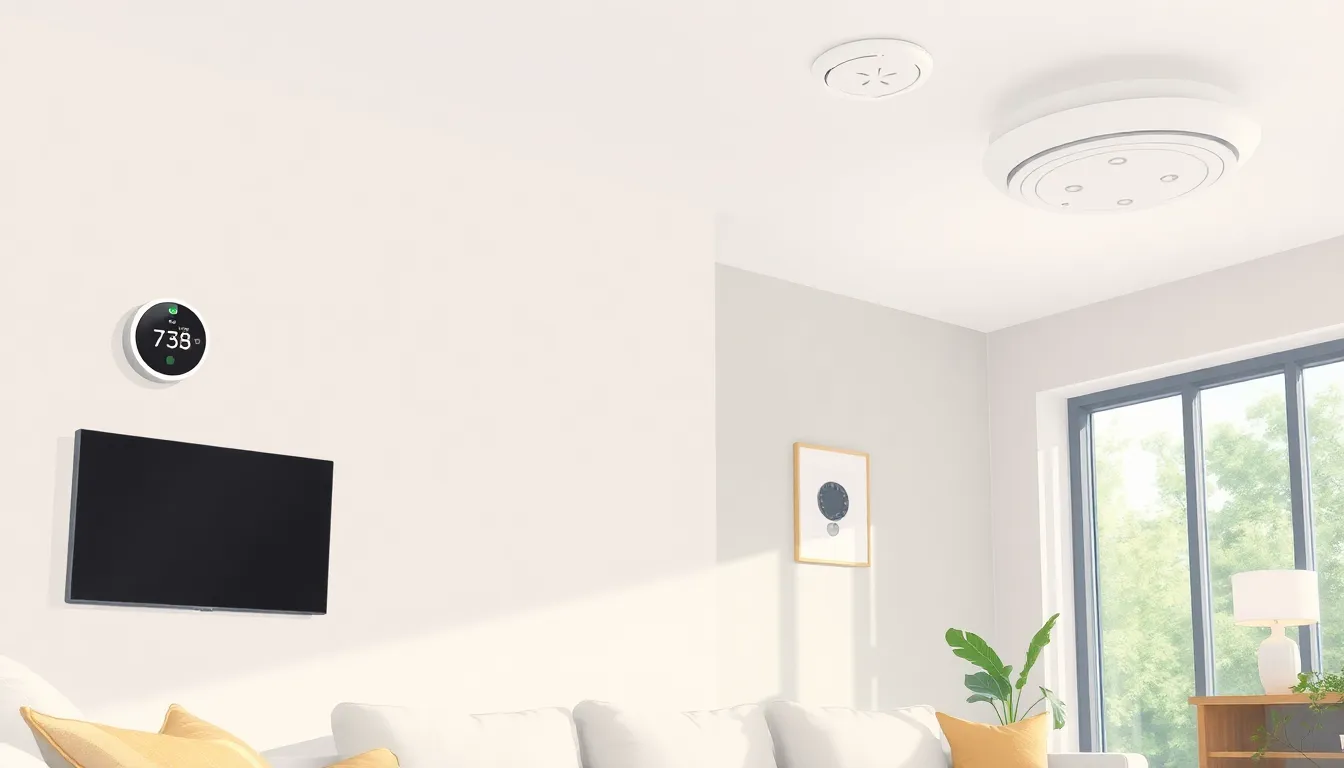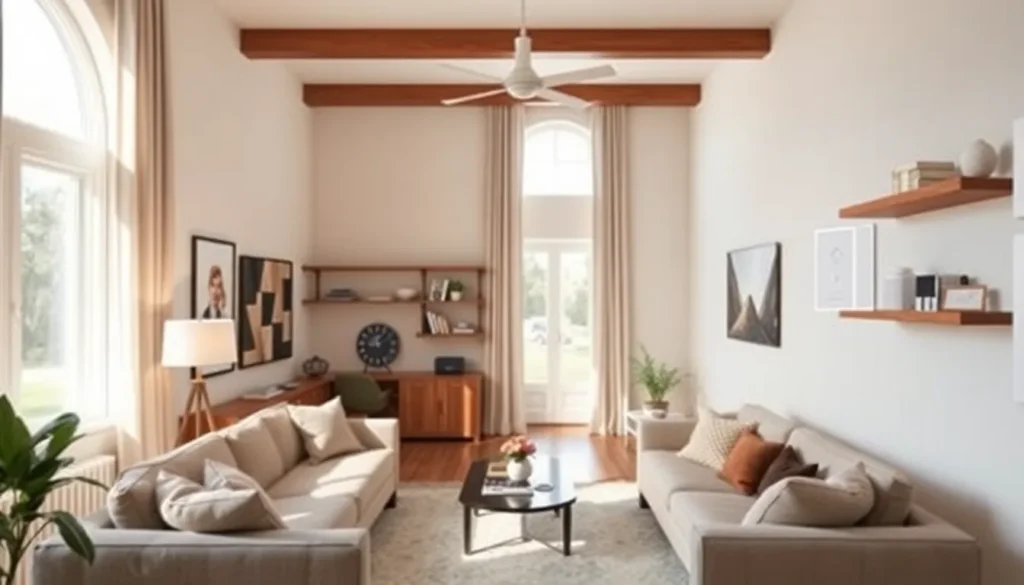Imagine a world where your home knows you better than your best friend. Home sensors are the unsung heroes of modern living, quietly working behind the scenes to make life easier, safer, and a whole lot smarter. These nifty gadgets can detect everything from motion to temperature changes, ensuring your home feels just right—like Goldilocks but without the porridge.
Home Sensors
Home sensors consist of various devices designed to improve household functionality and safety. They monitor environmental factors like temperature, humidity, motion, and light levels. Equipped with advanced technology, these sensors provide real-time data, enabling homeowners to make informed decisions.
Temperature sensors measure and report indoor climates. They trigger heating or cooling systems to maintain comfortable settings. Motion detectors capture movement within a space and serve to enhance security. When unexpected motion occurs, these sensors can alert homeowners through notifications or alarms.
Light sensors automatically adjust lighting based on surrounding brightness. They enhance energy efficiency by switching lights on or off according to natural light levels. Smoke detectors and carbon monoxide sensors work effectively to detect harmful gases. These devices ensure an immediate alert to potential dangers, safeguarding residents.
Integrating smart home systems allows for efficient communication among sensors. When one sensor detects an issue, it can prompt others to act accordingly, improving overall home safety. Home automation applications provide users with control over their sensor network. Such applications enable remote monitoring, allowing users to track their home’s status from anywhere.
In recent years, the demand for home sensors has increased. Statistics indicate that over 30% of households implement smart devices, driven by the desire for enhanced security and energy savings. As technology advances, these devices continue to evolve, offering innovative features to improve daily living experiences.
Types of Home Sensors

Home sensors play a critical role in enhancing safety, comfort, and efficiency within residential spaces. Various types of these devices cater to specific needs in a household.
Security Sensors
Security sensors protect homes by detecting unauthorized access. Motion detectors activate alarms when they sense movement, alerting homeowners to potential intrusions. Door and window sensors notify residents when entrances are opened unexpectedly. Surveillance cameras offer visual monitoring, allowing owners to review activity in real time. Reporting to control panels, these sensors work in harmony, creating a comprehensive security network that enhances peace of mind.
Environmental Sensors
Environmental sensors monitor conditions that affect comfort and safety. Temperature sensors adjust heating and cooling systems based on indoor climate fluctuations, ensuring comfort throughout the day. Humidity monitors detect moisture levels, helping prevent mold growth. Smoke detectors provide immediate alerts to alarm residents of fire hazards, while carbon monoxide detectors sense dangerous gas levels. By collecting real-time data, these sensors enable proactive measures to maintain a healthy living environment.
Smart Home Sensors
Smart home sensors integrate seamlessly with home automation systems, enhancing user control. Smart thermostats adjust climate settings based on daily routines, optimizing energy use. Light sensors adapt indoor lighting to natural daylight levels, promoting energy efficiency and reducing electricity bills. These devices communicate with one another, allowing for centralized control through mobile applications. Homeowners benefit from convenience as they manage their sensor network remotely, creating a connected and responsive living space.
Benefits of Home Sensors
Home sensors provide numerous advantages for modern households. These devices enhance security, promote energy efficiency, and increase convenience, making them essential for today’s homeowners.
Increased Security
Home sensors significantly enhance security. Motion detectors alert homeowners to unexpected movement, while door and window sensors monitor entries and exits. Surveillance cameras add an extra layer of protection, providing real-time video feeds. Integrating these devices creates a comprehensive security network, ensuring that any potential threats are immediately addressed. Nearly 35% of homeowners report feeling safer with sensor technology. This increased sense of security fosters peace of mind, allowing individuals to enjoy their living spaces without worry.
Energy Efficiency
Energy efficiency improves greatly with home sensors. Temperature and light sensors adjust heating, cooling, and lighting automatically based on environmental conditions. For example, light sensors dim interior lights when ample natural light enters a room. Studies show that homes equipped with these sensors can see energy savings of up to 20%. Proactive management of energy consumption not only lowers utility bills but also contributes to environmental sustainability. The ability to monitor energy use in real-time empowers homeowners to make informed choices that reduce wastage.
Convenience
Convenience is another key benefit of home sensors. Smart home systems allow users to control their devices remotely, enabling adjustments from anywhere. For instance, receiving alerts for unusual activity or changes in temperature means homeowners can respond immediately. Seamless integration with apps simplifies management, making everyday tasks more efficient. As a result, homeowners experience a higher quality of life, allowing for more time to focus on personal priorities. Effortless control over home environments contributes to overall satisfaction.
Considerations When Choosing Home Sensors
Selecting the right home sensors involves several essential factors. Each choice contributes to the overall effectiveness and integration of a sensor network.
Compatibility with Smart Home Systems
Check compatibility with existing smart home systems to ensure seamless operation. Many sensors work best with specific platforms like Amazon Alexa or Google Assistant. Products designed for interoperability often provide better integration. Look for devices that support popular standards such as Z-Wave or Zigbee, as these protocols improve communication among smart devices. Compatibility ensures that homeowners can control and monitor various sensors through a single app or interface.
Installation Requirements
Consider installation requirements before purchasing home sensors. Devices vary in complexity, with some requiring professional installation while others offer DIY options. Sensors like motion detectors often involve simple mounting, while environmental sensors may require calibration. Assess the home’s architecture, including wiring and locations, as this influences installation ease. Generally, proper placement ensures optimal performance and reliable monitoring.
Cost Factors
Evaluate cost factors to determine the budget for home sensors. Prices range significantly based on functionality, brand, and technology used. Basic sensors start around $20, while advanced models with multiple features can exceed $200. Additionally, consider subscription fees for cloud services or advanced monitoring options. Long-term savings from energy efficiency or enhanced security may outweigh initial investments. Always factor in potential installation costs when establishing a total budget.
Conclusion
Home sensors are transforming the way people interact with their living spaces. By seamlessly integrating security and environmental monitoring, these devices not only enhance safety but also promote energy efficiency and convenience. As homeowners embrace smart technology, the ability to control and monitor their environments remotely becomes a reality.
The growing popularity of home sensors reflects a shift toward more intelligent living solutions. With advancements in technology, the future holds even more innovative features that will further improve daily experiences. Investing in home sensors is a step toward a smarter, safer, and more efficient home.

